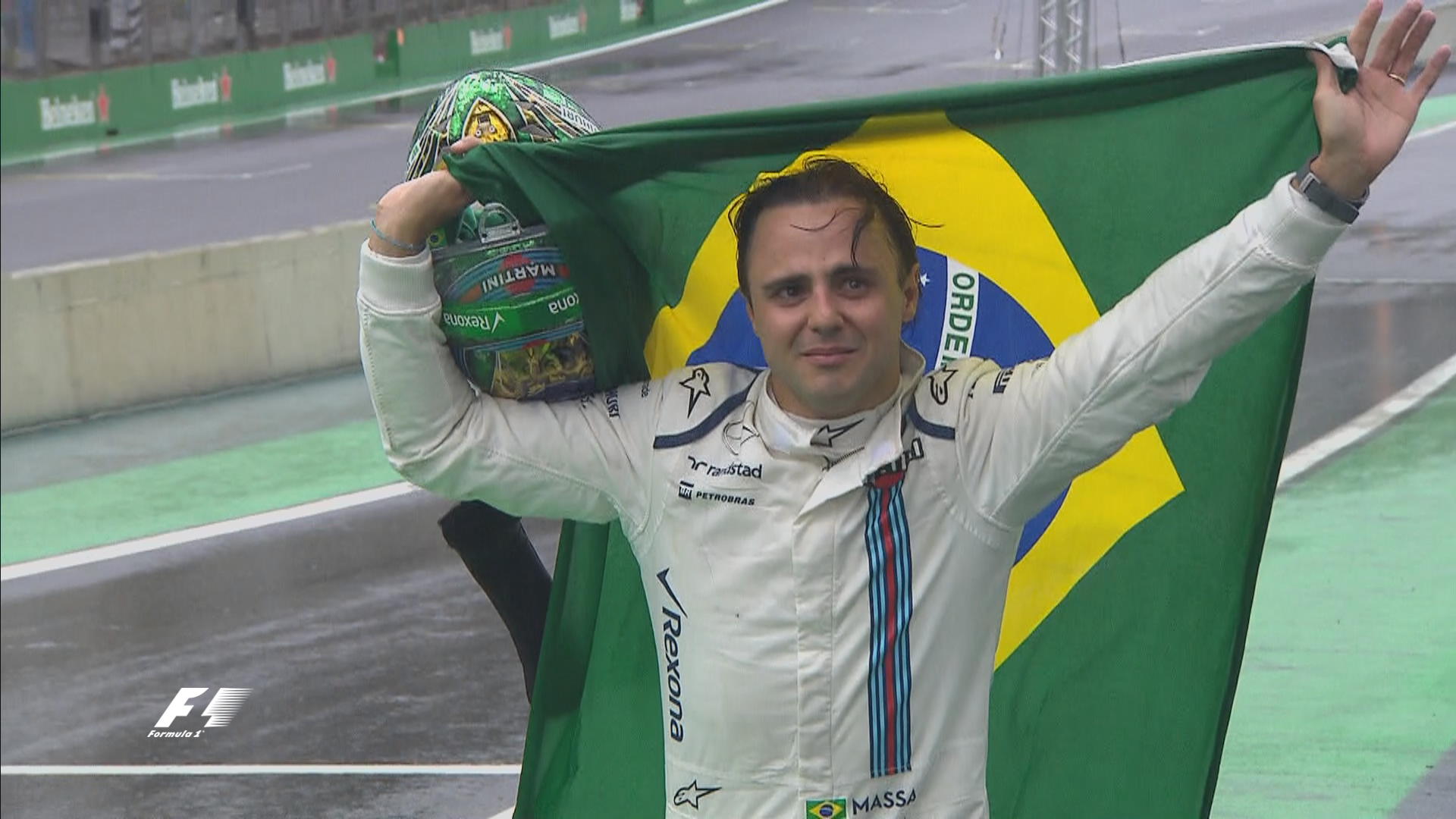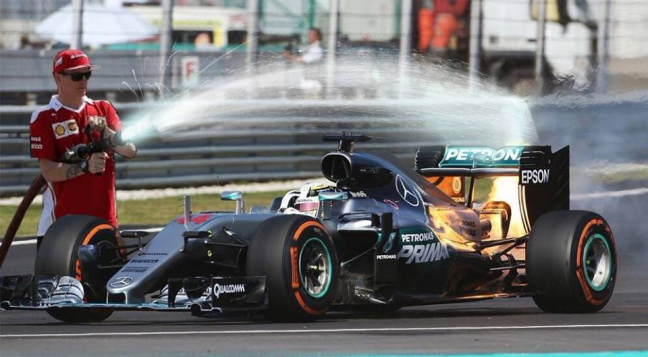
- Mercedes (1st, 765 points- Nico Rosberg (1st, 385pts)/Lewis Hamilton (2nd, 380pts)) 10.0
A third consecutive season of processional dominance for the boys from Brackley. Out of 59 Grands Prix since the start of 2014, they have won 51 races, 56 poles and 34 fastest laps. Out of an accumulated total of 3,551 laps, they have led 2,969 of them- a whopping 83.6%. They have consistently maintained a qualifying lap average of 0.7 seconds over their rivals, so there have a few conspiracy theorists, who have suggested that the Mercedes hierarchy secretly harboured to see a Nico Rosberg WDC victory to prove their accomplishments stemmed from the engineering solely. No team has sustained such dominance within such a time frame- not even Ferrari succeeded in doing this between 1999-01 and 2002-04, when they won an unprecedented six consecutive constructors’ world championships.
From 1999-2001, Ferrari won 25 races, 24 poles & 14 fastest laps out of 50 Grands Prix. Out of 3,139 laps, the Scuderia led 1,531 of them (48.8%). From 2002-2004, Ferrari won 38 races, 30 poles & 34 fastest laps (66.6%) (this is the only statistic higher than Mercedes’) out of 51 Grands Prix. Out of 3,230 laps, the Maranello boys led 2,033 of them (62.9%). During these years, F2002 & F2004 were their two most prominent cars, which were praised for their excellent mechanical grip, neutral handling and near bullet-proof reliability- F2002 recording just one mechanical failure, whilst F2004 clocked up none.
Red Bull, from 2011-13, won 32 races, 37 poles & 29 fastest laps out of 58 Grands Prix. Out of 3,456 laps, they led 1,985 of those laps (57.4%). During these years, RB11 & RB13 were their two most prominent cars, which were estimated by aerodynamicists as producing the most amount of downforce seen in any F1 cars before or since.
Williams, from 1992-1994, won 27 races, 36 poles & 29 fastest laps out of 48 Grands Prix. Out of 3,127 laps, they led 1,829 of them (58.5%). During these cars, FW14B & FW15C were their two most prominent cars, acknowledged by experts to be the most technologically complex machinery- active suspension, ABS brakes, traction control plus numerous other gizmos, leading Alain Prost to describe FW15c as a “mini Airbus”.
McLaren, from 1988-1990, won 31 races, 42 poles & 23 fastest laps out of 48 Grands Prix. Out of 3,122 laps, they led 2,376 of them (76.1%). In qualifying, their two prominent cars MP4-4 & MP4-5 blew their rivals away, capable of defeating the fastest non-McLaren car by up to three seconds in the hands of one-lap master Ayrton Senna. If the relationship between Prost and Senna hadn’t been so acrimonious and reliability wasn’t such a prevalent issue, it is possible the statistics in this period would match or even beat what Mercedes have achieved.
In terms of what Mercedes have achieved compared to rival teams in the modern era, it is similar to the astounding dominance achieved by individual drivers such as Juan Manuel Fangio, Jim Clark, Michael Schumacher and Sebastian Vettel. It is unlikely we’ll ever see such supremacy from a team on such a totalitarian scale, so that should be a welcome sigh of relief for fans.
Of course, the 10.0 mark was not only awarded for their car’s third consecutive year of crushing superiority, but also the team’s management. Despite controversy in Spain, Canada & Austria, relations remained stable between their star drivers, allowing them to seal the WCC at Suzuka with four races to spare.

2. Red Bull-TAG Heuer (2nd, 468 points- Daniel Ricciardo (3rd, 256 pts)/Max Verstappen (5th, 204 pts)/Daniil Kvyat (14th, 25 pts)) 9.0
After last year’s debacle, which led to Red Bull badging their Renault engines after their new sponsor, 2016 showed a huge leap forward. 2017 should present a permissible opportunity to return to the front, with Ricciardo and Verstappen hogging the headlines. It is expected star designer Adrian Newey will pen a chassis to exploit the aggressively increased downforce and tyres regulations to the absolute maximum, whilst Renault provide a power unit with ample grunt.

3. Force India-Mercedes (4th, 173 points- Sergio Perez (7th, 101 points)/Nico Hulkenberg (9th, 72 points)) 8.5
The Silverstone-based team’s gradual ascent through F1’s hierarchy was richly rewarded with their best-ever WCC finish of 4th. It is unlikely such a result will be achieved in 2017, but credit where credit is due. The designers exploited the current regulations’ need for drag reduction and straight-line speed, which permitted the chassis to lap quickly thanks to the invaluablely-endowed Mercedes power unit. It is debatable that in the hands of the best drivers (i.e. Alonso, Hamilton & Verstappen), the VJM09 could have pushed Ferrari for 3rd in the WCC. Loyal stalwart Hulkenberg will leave for Renault, so for 2017, promising talent Esteban Ocon takes his place.

4. Toro Rosso-Ferrari (7th, 63 points- Carlos Sainz (12th, 46 pts)/Daniil Kvyat (14th, 25 pts)/Max Verstappen (5th, 204 pts)) 8.0
A second consecutive season of progress for Faenza boys was rewarded with another 7th in the WCC. If Verstappen had remained at the team for the entirety of the season, they might have caught McLaren for 6th, but their 2015-spec Ferrari power unit proved their Achilles’ Heel. It is expected for Toro Rosso to move up in 2017, with the excellent Carlos Sainz spearheading their challenge.

5. McLaren-Honda (6th, 76 points- Fernando Alonso (10th, 54 pts)/Jenson Button (15th, 21 pts)/Stoffel Vandoorne (20th, 1 pt)) 7.5
A steady, if unspectacular, second season of the reunited fabled McLaren-Honda partnership. The car still suffered from a fair degree of understeer and the Honda power unit underwhelming in its overall output, but reliability was a welcome boost. Alonso did his usual miracle job, whilst Button floundered, scoring just five more points than last year. In his place for 2017 will be Vandoorne, who lit the paddock with illuminating reviews with his dazzling performance at his sole outing at Bahrain, whilst deputising for Alonso. The Spaniard will be not be feeling too comfortable, though, as memories of a particular rookie tearing his reputation to shreds will see its tenth anniversary.

6. Haas-Ferrari (8th, 29 points- Romain Grosjean (13th, 29 pts)/Esteban Gutierrez (21st, o pts)) 7.0
In their first two races, America’s newest team became the first team since Toyota in their debut consecutive Grands Prix to score points. What’s more, Grosjean finished P6 in Melbourne, then P5 in Bahrain thanks to excellent pit calls. As the season progressed, though, Haas ran through the typical stumbling blocks every new team encounters in their early hurdles of the unforgiving environment of F1. Lack of experience of set-ups and the narrow operating windows of the Pirellis, as well as dubious feedback from their drivers exacerbated their acute struggles at certain races, with Mexico being their nadir with P19 & P20. Gutierrez finished P11 five times and did well to beat his French team-mate during mid-season, but he never appeared to have the spark to produce a vital points finish. In his place for 2017 will be Kevin Magnussen, who will be hoping to improve upon his lacklustre 2016.

7. Williams-Mercedes (5th, 138 points- Valtteri Bottas (8th, 85 pts)/Felipe Massa (11th, 53 pts)) 6.5
After two years of enjoying the fruits of a remarkable revival with two consecutive 3rds in the WCC, my prediction of a third consecutive P3 was pathetically wrong. Strategic errors remained prevalent, which were exacerbated further by lack of development and critics slamming their low-drag, low-downforce design philosophy as one-dimensional. Lance Stroll will be a welcome addition with exorbitant funding by his billionaire tycoon father, but with Nico Rosberg’s shock retirement, the second seat is a major conundrum. Will Bottas go to Mercedes? And if he does, will Felipe Massa postpone his retirement for one more season?

8. Renault (9th, 8 points- Kevin Magnussen (16th, 7 pts)/Jolyon Palmer (18th, 1 pt)) 5.5
Were they racing in 2016? It was a poor return to F1 for the double WCC-winning French marque, who insisted upon using a revised 2015 Lotus chassis as their challenger this season. It is understandable that due to cash flow issues Lotus suffered, as well as time constraints linked with their late buyout, that the car was hurried, but development did not produce desired improvements. Cyril Abitedoul stated an intent to sign a “charismatic” lead driver, so it remains to be seen if Nico Hulkenberg can live up to such a lofty position.

9. Manor-Mercedes (11th, 1 point (Pascal Wehrlein (19th, 1 pt)/Esteban Ocon (23rd, 0 pts)/Rio Haryanto (24th, 0 pts) 5.0
A decent season for the Banbury-based squad. In spite of a car that lacked downforce, it topped top speed sheets regularly thanks to drawing inspiration from technical partners Williams, who sourced out their suspension and transmission. Wehrlein impressed in parts, whilst Pertamina-backed Haryanto lost his drive when the dollars dried up, as his race performances were inadequately under par. Ocon took his place, producing a great drive in Brazil before he spun. The point he lost for P10 proved academic as Sauber’s Felipe Nasr scored two vital points in P9, thrusting the Hinwil squad into 10th in the WCC. So that left Manor languishing in 11th for a second consecutive year. As ever with the backmarkers, their driver line-up will announced at the last minute before next year’s much anticipated tests.

10. Sauber-Ferrari (10th, 2 points- Felipe Nasr (17th, 2 pts)/Marcus Ericsson (22nd, o pts)) 4.0
In a season of mounting financial pressures, further burdened by two mediocre pay drivers and a bland corporate image, it was a miracle Sauber escaped the wooden spoon in the WCC and on this list. To be frankly honest, Monisha Kaltenborn clearly has a lucky charm somewhere. The car was rehash of last year’s decent contender, so it was inevitably predictable how poor this season was going to be. All year, the Hinwil team appeared destined to see a 11th finish to darken their worries over the long-term existence of Sauber, but the heavens opened in Interlagos and the rest is history. Marcus Ericsson is confirmed in one of their seats for 2017, but it remains to seen whether Nasr has the funding to continue.
The next article will focus on this year’s Reject Team of the Year. Don’t miss it!















